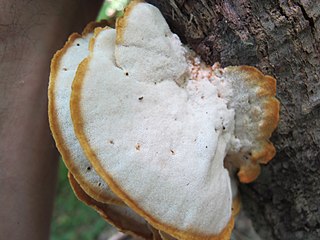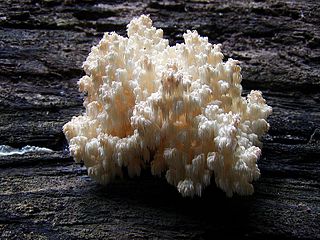
Hydnum repandum, commonly known as the sweet tooth, wood hedgehog or hedgehog mushroom, is a basidiomycete fungus of the family Hydnaceae. First described by Carl Linnaeus in 1753, it is the type species of the genus Hydnum. The fungus produces fruit bodies (mushrooms) that are characterized by their spore-bearing structures—in the form of spines rather than gills—which hang down from the underside of the cap. The cap is dry, colored yellow to light orange to brown, and often develops an irregular shape, especially when it has grown closely crowded with adjacent fruit bodies. The mushroom tissue is white with a pleasant odor and a spicy or bitter taste. All parts of the mushroom stain orange with age or when bruised.

Climacodon pulcherrimus is a species of tooth fungus in the family Phanerochaetaceae. It was first described as a species of Hydnum by Miles Berkeley and Moses Ashley Curtis in 1849. T.L. Nikolajeva transferred it to its current genus Climacodon in 1962, but research published in 2007 suggests it should be placed in a different genus. It is widely distributed in subtropical and tropical areas, where it grows on decomposing hardwoods, causing a white rot.

Hydnum is a genus of fungi in the family Hydnaceae. They are notable for their unusual spore-bearing structures of teeth rather than gills. The best known are the edible species Hydnum repandum and H. rufescens. There are no known toxic varieties of Hydnum. Widely regarded as important maintainers of forest ecosystems, the Hydnum genus is known to have ectomycorrhizal relationships with multiple plant families. Hydnum has many brittle, white teeth from which the spores drop. Some species have teeth which hang from ascending branches, while other species have teeth which project downwards from the undersurfaces of dead wood. Most Hydnum species are safe to eat, and contain many fatty acids and antioxidants.

Hydnellum is a genus of tooth fungi in the family Bankeraceae. Widely distributed in the Northern Hemisphere, the genus contains around 40 species. The fruitbodies of its members grow by slowly enveloping nearby bits of grass and vegetation. There is great variability in the form of Hydnellum fruitbodies, which are greatly influenced by environmental conditions such as rainfall and humidity, drying winds, and temperature. They are too tough and woody to eat comfortably. Several species have become the focus of increasing conservation concern following widespread declines in abundance.

The Hydnaceae are a family of fungi in the order Cantharellales. Originally the family encompassed all species of fungi that produced basidiocarps having a hymenium consisting of slender, downward-hanging tapering extensions referred to as "spines" or "teeth", whether they were related or not. This artificial but often useful grouping is now more generally called the hydnoid or tooth fungi. In the strict, modern sense, the Hydnaceae are limited to the genus Hydnum and related genera, with basidiocarps having a toothed or poroid hymenium. Species in the family are ectomycorrhizal, forming a mutually beneficial relationship with the roots of trees and other plants. Hydnum repandum is an edible species, commercially collected in some countries and often marketed under the French name pied de mouton.

Bankera is a genus of four species of tooth fungi in the family Bankeraceae. The genus was first circumscribed in 1951 by William Chambers Coker and Alma Holland Beers, but this publication was invalid according to the rules of botanical nomenclature. It was later published validly by Zdeněk Pouzar in 1955. The type species is B. fuligineoalba. The genus is ectomycorrhizal with gymnosperms, usually with trees from the pine family.

Phellodon is a genus of tooth fungi in the family Bankeraceae. Species have small- to medium-sized fruitbodies with white spines on the underside from which spores are released. All Phellodon have a short stalk or stipe, and so the genus falls into the group known as stipitate hydnoid fungi. The tough and leathery flesh usually has a pleasant, fragrant odor, and develops a cork-like texture when dry. Neighboring fruitbodies can fuse, sometimes producing large mats of joined caps. Phellodon species produce a white spore print, while the individual spores are roughly spherical to ellipsoid in shape, with spiny surfaces.

Hericium is a genus of edible mushrooms in the family Hericiaceae. Species in this genus are white and fleshy and grow on dead or dying wood; fruiting bodies resemble a mass of fragile icicle-like spines that are suspended from either a branched supporting framework or from a tough, unbranched cushion of tissue. This distinctive structure has earned Hericium species a variety of common names—monkey's head, lion's mane, and bear's head are examples. Taxonomically, this genus was previously placed within the order Aphyllophorales, but recent molecular studies now place it in the Russulales.
Stegiacantha is a fungal genus in the family Meruliaceae. It is a monotypic genus, containing the single species Stegiacantha petaloides, found in Madagascar. This fungus was first described by American mycologist Curtis Gates Lloyd in 1913 as Hydnum petaloides. Rudolph Arnold Maas Geesteranus circumscribed Stegiacantha to contain the fungus in 1966.

The hydnoid fungi are a group of fungi in the Basidiomycota with basidiocarps producing spores on pendant, tooth-like or spine-like projections. They are colloquially called tooth fungi. Originally such fungi were referred to the genus Hydnum, but it is now known that not all hydnoid species are closely related.

Sistotrema is a genus of fungi in the family Hydnaceae. The genus contains at least 55 species and has a worldwide distribution. The type species is Sistotrema confluens Pers. (1794).

Hydnellum fuscoindicum is a species of tooth fungus in the genus Hydnellum. It is found in the Pacific Northwest in moss around western hemlocks. It produces fruit bodies with a violet-black cap, violet flesh, and violet spines on the cap underside. The odor and taste are very farinaceous. The fungus was first described by Kenneth A. Harrison in 1964 as a species of Hydnum, then transferred to Sarcodon in 1967 by Rudolph Arnold Maas Geesteranus. He placed this species in section Violacei of Sarcodon, along with H. fuligineoviolaceum and H. joeides.
Phellodon plicatus is a species of tooth fungus in the family Bankeraceae. Found in Australia, it was first described in 1925 by Curtis Gates Lloyd as a species of Hydnum. Dutch mycologist Rudolph Arnold Maas Geesteranus transferred it to the genus Phellodon in 1966.
Sarcodon bubalinus is a European species of tooth fungus in the family Bankeraceae. First described by Christian Hendrik Persoon in 1825 as Hydnum bubalinum, it was transferred to the genus Sarcodon by Rudolph Arnold Maas Geesteranus in 1956.

Sarcodon rimosus, commonly known as the cracked hydnum, is a species of tooth fungus in the family Bankeraceae. Found in the Pacific Northwest region of North America, it was described as new to science in 1964 by mycologist Kenneth A. Harrison, who initially called it Hydnum rimosum. He transferred it to the genus Sarcodon in 1984. Fruit bodies of S. rimosum have convex to somewhat depressed caps that are 4–12 cm (1.6–4.7 in) in diameter. The surface becomes scaly in age, often developing conspicuous cracks and fissures. It is brown with violet tints. The flesh lacks any significant taste and odor. Underneath the cap cuticle, the flesh turns a bluish-green color when tested with a solution of potassium hydroxide. The brownish-pinks spines on the cap underside are typically 2.5–7 mm long, extending decurrently on the stipe. Spores are roughly spherical with fine warts on the surface, and measure 5–6.5 by 4.5–5 µm. The hyphae do not have clamp connections.
Sarcodon cyanellus is a species of tooth fungus in the family Bankeraceae. Found in the Pacific Northwest region of North America, where it associates with Pinaceae, it was described as new to science in 1964 by mycologist Kenneth A. Harrison, who initially called it Hydnum cyanellum. He transferred it to the genus Sarcodon in 1984. It has a vinaceous-violet to bluish-black cap.

Sarcodon calvatus is a species of tooth fungus in the family Bankeraceae. It was described as new to science in 1964 by mycologist Kenneth A. Harrison, who initially called it Hydnum calvatum. He transferred it to the genus Sarcodon in 1984. It is found in North America.

Hydnellum gracilipes is a species of tooth fungus in the family Bankeraceae. It was first described scientifically in 1886 by Petter Karsten, who called it Hydnum gracilipes. He transferred it to the genus Hydnellum in 1879. Fruit bodies of the fungus have a pinkish to reddish-brown colour, a delicate texture described as "felty or papery", and flimsy stipes. Its spores are roughly spherical with a diameter of no more than 5 µm. H. gracilipes is found in northern Europe, where it is mycorrhizal with pine. Collections made in Scotland have been found by lifting the dense ground cover of common heather, which the fungus seems to use to as support to compensate for its flimsy stipe.

Hydnophlebia omnivora is a species of crust fungus in the family Meruliaceae. It causes white rot in various woody angiosperms, being found in arid regions of the Southern United States, northern Mexico, and Uruguay.














